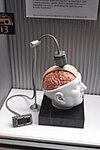BrainGate
BrainGate is a
Technology

In its current form, BrainGate consists of a sensor implanted in the brain and an external decoder device, which connects to some kind of
In addition to real-time analysis of neuron patterns to relay movement, the BrainGate array is also capable of recording electrical data for later analysis. A potential use of this feature would be for a
History
BrainGate was originally developed by researchers in the Department of Neuroscience at Brown University in conjunction with bio-tech company Cyberkinetics, Inc. Cyberkinetics later spun off the device manufacturing to Blackrock Microsystems, who now manufactures the sensors and the data acquisition hardware.[2] The BrainGate Company purchased the intellectual property and related technology from Cyberkinetics and continues to own the intellectual property related to BrainGate.[1][2]
Research and experimental results
The first reported experiments involving the implantation of the microelectrode array in one human subject were carried out in 2002 by Kevin Warwick, Mark Gasson and Peter Kyberd.[3] The procedure, which was performed at the Radcliffe Infirmary, involved the implantation of the array in the peripheral nerves of the subject in order to successfully bring about both motor and sensory functionality, i.e. bi-directional signalling.[4]
The subsequent full clinical trial of BrainGate was led by researchers at
In July 2009, a second clinical trial, dubbed "BrainGate2", was initiated by researchers at Massachusetts General Hospital, Brown University, and the Providence VA.[7][8] In November 2011, researchers from the Stanford University Neural Prosthetics Translational Laboratory joined the trial as a second site.[9] This trial is ongoing.
In May 2012, BrainGate researchers published a study in Nature demonstrating that two people paralyzed by
Current clinical trials
Clinical trials began in 2009 under the name "BrainGate2 Neural Interface System".[16][17] As of October 2014[update], Stanford University, Massachusetts General Hospital, Case Western Reserve University (Ohio) and Providence VA Medical Center were actively recruiting participants for the ongoing BrainGate2 clinical trial.[17]
In April 2021, BrainGate became the first technology to transmit wireless commands from a human brain to a computer. The clinical study used two participants with spinal cord injuries. The study used a transmitter connected to the subject's brain motor cortex to transmit the signals. The accuracy and speed of typing and movement was reported to be identical to that of wired solutions.[18]
See also
- Brain–computer interface – Describes human trials with BrainGate
- Kernel (neurotech company)
- Neuralink
- Neurorobotics
- Simulated reality
References
- ^ a b Kirsner, Scott (12 August 2009). "CyberKinetics' Brain-to-Computer Interface Gets a Second Chance". Boston.com. Retrieved 5 April 2021.
- ^ a b "Neuroscience Research Systems Blackrock Microsystems". Retrieved 5 April 2021.
- ^ Legato, M Editor: ”Principles of Gender-Specific Medicine”, Academic Press, 2017
- S2CID 4347367.
- ^ "Mind Control". Wired. 1 March 2005.
- ^ "BrainGate - Turning thought into Action". 2015-12-04.
- ^ "BrainGate2: Feasibility Study of an Intracortical Neural Interface System for Persons With Tetraplegia (BrainGate2)".
- ^ Tanya Lewis. "Stanford joins BrainGate team developing brain-computer interface to aid people with paralysis". Stanford School of Medicine. Archived from the original on 9 December 2011.
- PMID 22596161.
- ^ "Paralysed woman moves robot with her mind - by Nature Video". YouTube: Nature video. 16 May 2012. Archived from the original on 2021-12-22. Retrieved 5 April 2021.
- ^ "People with paralysis control robotic arms using brain-computer interface". Brown University. May 2012.
- S2CID 61793032.
- ^ a b "People with paralysis control robotic arms using brain-computer interface". Brown University. 16 May 2012.
- ^ "The Boston Home Connection to a technology breakthrough". 16 May 2012. Archived from the original on 15 November 2013. Retrieved 30 October 2012.
- ^ "Clinical Trials". Retrieved 5 April 2021.
- ^ a b "BrainGate2: Feasibility Study of an Intracortical Neural Interface System for Persons With Tetraplegia (BrainGate2)". ClinicalTrials.gov. Retrieved 5 April 2021.
- ^ Cuthbertson, Anthony (3 April 2021). "Scientists connect human brain to computer wirelessly for first time ever". The Independent. Retrieved 5 April 2021.

